INTRODUCTION
Height is determined not only by genetic factors but also by environmental factors. However, in some cases, it may not be possible to achieve the desired height through natural methods. For example, once the growth plates have closed, it is no longer possible to lengthen bones naturally. At this point, height lengthening surgery comes into play. This surgical method, offered by modern medicine, aims to help individuals increase their height. So, what is height lengthening surgery, how is it performed, and what criteria determine its application? You can find the answers to all these questions in this guide. At Wannabetaller.com, we strive to provide the most accurate and up-to-date information in this field.
WHAT IS LIMB LENGTHENING SURGERY
Limb lengthening surgery is a procedure that aims permanently increasing a person’s height through specialized surgical techniques applied to the leg bones. During this procedure, the bone is carefully cut by an orthopedic surgeon, creating a controlled gap between the two ends. The body’s natural bone production fills this gap with new tissue, and the leg is gradually lengthened by 1 mm per day. Regular doctor check-ups, adherence to physical therapy, and exercise are critical for a healthy recovery throughout the process.
In this comprehensive guide, we will cover the most frequently asked topics about limb lengthening surgery, including its history, pre-operative evaluation, surgical process, methods used (e.g., internal nails placed inside the bone or external fixators attached outside the leg), key stages of the recovery period, physical therapy and rehabilitation practices, potential risks, costs, choosing the right doctor, and frequently asked questions about limb lengthening surgery in Turkey.
HISTORY OF LIMB LENGTHENING SURGERY

Limb lengthening surgeries found their place in modern medicine in the mid-20th century with the method developed by Soviet orthopedic surgeon Gavriil Ilizarov. Ilizarov introduced the principle of gradually lengthening bones by carefully breaking them and using a specialized external fixator. This method, which supported the natural healing process of bones to achieve lengthening, revolutionized the treatment of conditions such as leg length discrepancies (shortening of one leg). Initially developed for military rehabilitation, this technique eventually gained global acceptance and became widespread.
Since the 1980s, advancements in medical device technology have made it possible to perform limb lengthening surgeries for aesthetic purposes. In the 1990s, less invasive methods using intramedullary nails, which involve smaller surgical procedures and leave fewer scars, began to emerge. Devices such as Fitbone, Betzbone, Guichet Nail, and Precice, which use magnetic-controlled nails, marked a breakthrough in the field. During the same period, the Combined (LON) method, which combines internal nails with external fixators, became an effective technique. Known for its affordability and faster recovery process, this method has become an ideal option for many patients worldwide. Modern techniques have not only accelerated the recovery process but also minimized the risks of complications, making limb lengthening surgeries safer and more comfortable. Today, these surgeries are widely performed to address both aesthetic and medical need.
HOW IS LIMB LENGTHENING SURGERY PERFORMED?
Limb lengthening surgery is typically carried out in several stages:
Evaluation and Planning
Before the surgery, the patient’s overall health, bone structure, and expectations are assessed. X-rays, Ortho radiographs, bone mineral density tests (for individuals over 40), and other imaging techniques are used to evaluate the condition of the bones. Additionally, a psychological evaluation is conducted to determine if the patient is prepared for the surgery.
Surgical Procedure
The surgery is typically performed under general anesthesia. The surgeon cuts the bone at the thigh (femur) or lower leg (tibia) at the most suitable location for lengthening and places the chosen lengthening device, such as an internal nail or external fixator.
Lengthening Process
After the surgery, the bones are gradually lengthened by approximately 1 mm per day at regular intervals. This process stimulates the natural regeneration of bone tissue. The lengthening duration may vary depending on the method used and the length of extension desired.
Recovery and Rehabilitation
Once the bones have been sufficiently lengthened, the device (nail or fixator) is removed, and physical therapy begins. The recovery period generally takes several months, during which regular check-ups are conducted. For a typical lengthening of 7 cm, patients can begin resuming their daily activities within 4-6 months. However, for intense physical activities like heavy sports, sprinting, or high jumps, full bone consolidation is necessary, which can take 1 to 1.5 years.
During this recovery period, patients must regularly send X-ray images and physical updates to their doctor through consultations or communication tools. Under the doctor’s supervision, patients can gradually return to their desired activities at their new height.
ADVANTAGES AND DISADVANTAGES OF LIMB LENGTHENING SURGERY: A REALISTIC PERSPECTIVE

Advantages
- Physical and Psychological Benefits: Increased height boosts self-confidence and helps individuals feel more comfortable in social settings.
- Permanent Solution: The gained height is retained for life.
- Comfort of Modern Techniques: Methods such as Precice and Combined techniques speed up the recovery process and the return to normal life.
- Medical Problem Resolution: Issues like leg length discrepancies or dwarfism can be treated effectively.
Disadvantages
- Long Recovery Period: Full bone consolidation may take 1-1.5 years.
- Physical Discomfort: Pain and tension can be experienced during the lengthening process.
- High Cost: It requires a higher budget compared to other cosmetic procedures.
- Risk of Complications: Rare risks such as infection or non-union of bones may occur.
- Psychological Challenges: The lengthy treatment process can lead to loss of motivation.
Limb lengthening surgery offers a permanent solution but requires patience and discipline. To evaluate its advantages and disadvantages, thorough research, discussions with past patients, and expert guidance are crucial. You can watch our psychological counselor’s views on this topic in the video below.
LIMB LENGTHENING SURGERY METHODS
The methods used in limb lengthening surgery vary depending on the needs, budget, and expectations of each patient. Advances in technology have led to the development of various methods, each with its own advantages and disadvantages. Below are the four most common methods used in limb lengthening surgeries and their features:
Ilizarov Method
The Ilizarov method is the first modern technique used in limb lengthening surgeries and relies on external fixators. In this method, controlled lengthening is achieved through rings and wires attached to the bone.
Advantages:
- Low cost makes it an economical option.
- Effective for correcting severe leg length discrepancies and bone deformities.
Disadvantages:
- Higher risk of infection due to the prolonged use of external fixators.
- Restricts daily activities and may cause aesthetic concerns.
- Recovery (removal of the fixators) takes longer compared to other methods, typically 9-12 months for 7 cm of lengthening.
LON Method
The LON method uses a combination of internal nails and external fixators. It is a more comfortable and quicker alternative compared to the Ilizarov method.
Advantages:
- External fixators remain on the leg for only 2-3 months, reducing the risk of infection.
- Affordable and cost-effective.
- Allows supported walking, making the psychological and physical process more manageable for patients.
Disadvantages:
- Even temporary use of external fixators can limit movement and comfort.
- Requires three surgeries: lengthening surgery, external fixator removal, and optional removal of the internal nail.
Precice Method
The Precice method involves the use of intramedullary nails that are fully implanted inside the bone, offering a minimally invasive option (fewer surgical procedures, less scarring). These nails are controlled remotely using a magnetic device for precise daily lengthening.
Advantages:
- Minimal infection risk as no external fixators are used.
- No external devices, eliminating aesthetic concerns.
- Provides a less painful and more comfortable recovery process.
Disadvantages:
- More expensive than other methods.
- Rare risk of malfunction in the magnetic mechanism of the nail.
- Limited weight-bearing capacity during recovery, requiring caution.
- Maximum lengthening capacity is 8 cm (which can extend to 8.5 cm when accounting for the gap created during surgery).
You can observe the moment of lengthening with two methods in the video.
Precice Max Method
The Precice Max is the most advanced version of the Precice method and is considered a groundbreaking innovation in limb lengthening surgery.
Advantages:
- Enhanced weight-bearing capacity allows for quicker mobility.
- Minimally invasive with internal nails, resulting in fewer scars and a highly comfortable recovery process.
- FDA-approved, ensuring high safety standards.
Disadvantages:
- High cost makes it less accessible to everyone.
- Being a new technology, finding experienced surgeons can be challenging.
- Rare risks, such as malfunctions in the magnetic control device, still exist.
Conclusion: Which Method is Right for You?
The choice of method for limb lengthening surgery depends on factors such as the patient’s health condition, budget, aesthetic expectations, and recovery timeline. While the Ilizarov and Combined (LON) methods offer more cost-effective solutions, the Precice and Precice Max methods provide superior comfort and aesthetics at a higher cost. Selecting the most suitable method requires the guidance of an expert orthopedic surgeon to make the best decision.
WHO IS SUITABLE FOR LIMB LENGTHENING SURGERY?
Limb lengthening surgery is suitable for individuals who meet certain criteria, whether due to medical necessity or aesthetic expectations. To determine eligibility for the surgery, an evaluation with a specialist orthopedic surgeon is required. The following groups are considered the best candidates for limb lengthening surgery:
1. Those Considering Surgery for Medical Reasons
- Leg Length Discrepancy: Individuals with one leg shorter than the other due to congenital conditions or trauma.
- Dwarfism (Achondroplasia): Individuals experiencing short stature due to genetic causes.
- Injuries or Bone Loss: Those with bone deformities or leg shortening caused by trauma.
2. Those Seeking Limb Lengthening for Aesthetic Purposes
- Genetic Short Stature: Individuals looking to increase their height to boost confidence.
- Career and Social Expectations: Especially in professions like modeling or acting, where height is significant.
3. Age and General Health Requirements
- Age Range: Individuals whose growth plates have closed, typically between the ages of 18 and 55.
- General Health Condition: Those without severe health issues such as cardiovascular diseases, diabetes, or other serious medical conditions.
When deciding on limb lengthening surgery, it is crucial for candidates to be both physically and psychologically prepared for the process. A comprehensive evaluation conducted by an expert team ensures that this journey is completed safely and successfully.
You can watch and listen to the opinions of our doctor in the video below.
RISKS AND POTENTIAL COMPLICATIONS OF LIMB LENGTHENING SURGERY
Limb lengthening surgery is a safe procedure when performed by an experienced team. However, like any surgical operation, it carries certain risks and complications. Most of these risks can be prevented or managed with proper planning, the selection of a skilled surgeon, and regular follow-up care.
Infection
- Causes: Insufficient sterilization during surgery or poor hygiene in methods involving external fixators.
- Prevention and Treatment: Controlled through regular dressing, adherence to hygiene protocols, and antibiotic treatment.
Nonunion (Bone Healing Failure)
- Causes: Poor nutrition, genetic factors, smoking, or circulation problems.
- Solution: May require bone grafting, PRP/stem cell therapy, or additional surgical interventions.
Nerve and Blood Vessel Damage
- Symptoms: Numbness, tingling, weakness, or reduced motor function.
- Prevention: Selection of an experienced surgeon and regular physical therapy.
Muscle and Tendon Tightness
- Symptoms: Restricted movement and muscle stiffness.
- Treatment: Stretching exercises, massage, and physical therapy.
Psychological Stress and Loss of Motivation
- Causes: Long recovery period and social isolation.
- Support: Psychological counseling, focusing on the benefits of increased height, and connecting with other patients.
Device and Mechanical Issues
- Causes: Bending of the nail or malfunction of the magnetic control device.
- Solution: Regular device checks and surgical intervention if needed.
Conclusion: Minimizing Risks
Choosing an experienced surgeon, detailed surgical planning, and regular post-operative follow-ups are crucial to minimizing the risks associated with limb lengthening surgery. When patients adhere to the process and follow expert recommendations, these risks can be effectively managed.
RECOVERY PROCESS AFTER LIMB LENGTHENING SURGERY
The recovery process after limb lengthening surgery requires both physical and psychological adaptation. This period involves the stages of bone lengthening, bone healing, and regaining mobility. Regular doctor check-ups, physical therapy, and patient commitment play a critical role in ensuring successful recovery.
In the video below, we documented a day in the life of our patient after the surgery for you.
First Days After Surgery
- Hospital Stay: Typically, patients stay in the hospital for 4-5 days post-surgery. Pain management, dressing changes, and basic physical needs are handled by doctors and nurses during this time.
- Light Movements: By the second day, patients usually begin light movements with the help of a wheelchair or walker.
In the video below, the stages of movement and walking demonstrated by our patient throughout the process are detailed. Watch the video to see how the process unfolded.
Lengthening Phase
- Process: The lengthening process begins about 5 days after surgery. During this period, the bones are lengthened by approximately 1 mm per day, lasting 2-3 months for 7 cm of lengthening.
- Physical Therapy: Essential for muscles and joints to adapt to the lengthening. Stretching and strengthening exercises are applied during this phase.
- Psychological Support: Prolonged immobility can cause stress. Psychological counseling, staying connected with the doctor, and interacting with other patients can help.
Bone Healing and Rehabilitation
- Bone Healing Process: From the moment the bone is broken, healing begins. While 1 mm of daily lengthening continues, the body produces new bone tissue. Regular X-rays are required to monitor the healing process.
- Independent Walking: Depending on the bone healing status, patients can begin walking without support within 4-6 months. Full recovery and return to sports activities may take 1-1.5 years.
Long-Term Recovery
- Regaining Mobility: Patients who consistently attend physical therapy can regain their pre-surgery mobility.
- Reduction of Scars: With modern surgical techniques, scars are generally minimal and fade over time.
You can watch the video below to see how our patient regained mobility and improved quality of life after returning to normal daily activities.
Tips for Success
- Strictly follow the doctor’s instructions.
- Stay consistent with the physical therapy program.
- Pay attention to nutrition (diet rich in calcium and vitamin D).
- Maintain a patient and disciplined approach.
The recovery process after limb lengthening surgery can vary for each patient. For a smooth and effective recovery, it is important to receive support from an expert team and actively participate in the process as a patient.
LIMB LENGTHENING SURGERY PATIENTS: THE IMPORTANCE OF REAL EXPERIENCES
Accessing accurate information about a significant process like limb lengthening surgery is essential for those who are considering the surgery. The experiences of individuals who have undergone this surgery are an invaluable resource for understanding the real challenges, benefits, and effects on daily life. However, these experiences are not always easy to find. Many patients choose not to share their journey due to privacy concerns, while others may focus on specific aspects for entirely different reasons.
Why Are Real Experiences So Important?
Limb lengthening surgery is a long, detailed, and demanding process. The experiences of individuals who have undertaken this journey provide comprehensive insights into the psychological and physical challenges, recovery time, and outcomes. Understanding real patient experiences helps prospective patients make more informed and realistic decisions.
Challenges in Accessing Information
Finding accurate information in this field can be difficult for several reasons:
- Privacy and Confidentiality: Many patients view this process as a private matter and hesitate to share it with their social circles.
- Promotional Content: Some patients or companies present the process as easier and less demanding than it really is, sharing only the positive aspects. This type of content can mislead potential patients.
- One-Sided Narratives: Some patients focus solely on complications or challenges, making it harder to form a balanced and realistic perspective of the surgery process.
You can watch the experiences of our patient during this process in the video below.
How to Access Reliable Information?
To access accurate and balanced information, consider the following approaches:
1. Social Media and Patient Diaries
Many patients share their experiences on social media platforms or private forums. These resources can provide a realistic view of the surgery process. Platforms like Instagram and YouTube are particularly useful, as some patients detail their daily routines and recovery progress.
2. Request References from Your Surgery Center
Contact the center where you are planning to have the surgery and request the opportunity to talk directly with patients who have undergone the procedure. This helps you understand the process and gain insights about the doctor and team.
3. Patient Diaries and Stories
Written or video diaries that describe the post-surgery process in detail can serve as a valuable guide for those considering the surgery. These accounts allow you to see both the easy and challenging aspects of the journey.
CONCLUSION: ACHIEVING BALANCED AND REALISTIC INFORMATION
Before making a major decision like limb lengthening surgery, it is crucial to consider both positive and negative experiences to gain a balanced perspective. Following diverse patient stories can help you determine whether the process is suitable for you or not. Remember, every individual’s journey is unique, and comprehensive information is vital for making the right decision.
LIMB LENGTHENING SURGERY COSTS: EVERYTHING YOU NEED TO KNOW
Limb lengthening surgery requires a significant financial investment. The cost of the procedure varies depending on the method used, the surgeon’s expertise, the quality of the hospital, and additional services. Turkey has become a leading destination in this field, offering high-quality healthcare services at more affordable costs compared to many other countries.

1. Factors Affecting the Surgery Cost
- Method Used: Ilizarov and LON methods are more budget-friendly, while advanced technologies like Precice and Precice Max come with higher costs.
- Surgeon’s Experience: Surgeons with specialized expertise and experience may charge more, but they also minimize the risk of complications and provide a more comfortable recovery process.
- Hospital and Services: Hospitals equipped with modern technology and additional services such as accommodation, physical therapy, and transfer services significantly impact the cost.
2. Limb Lengthening Surgery Costs in Turkey
Turkey stands out as a country offering world-class limb lengthening services at competitive prices. As of 2025, the costs in Turkey are as follows:
- Ilizarov Method: $14,000–$18,000 USD
- LON Method: $20,000–$25,000 USD
- Precice Method: $44,000–$50,000 USD
- Precice Max Method: $50,000 USD and above
3. Services Included in the Surgery Cost
In Turkey, the cost of limb lengthening surgery typically includes:
- Pre-surgery tests and evaluations.
- Surgery and hospital stay (4 days).
- Surgical equipment and devices (nails, fixators).
- Medical equipment such as wheelchairs and walkers.
- Post-surgery dressing, physical therapy, and doctor follow-ups.
4. Insurance and Payment Options
Limb lengthening surgery is generally considered a cosmetic procedure, so it is often not covered by insurance. However, surgeries performed for medical reasons, such as dwarfism or significant leg length discrepancies, may have partial coverage from some insurance companies. Many hospitals and clinics in Turkey offer flexible payment options, including cash, credit card, or bank transfer.
5. Affordable Prices, High Quality
Affordable costs for limb lengthening surgery in Turkey do not compromise quality. With advanced technology, experienced surgeons, and modern hospital infrastructure, Turkey has become one of the most preferred countries globally for this procedure.
When evaluating the cost of limb lengthening surgery, it is essential to consider not just the price but also the surgeon’s expertise, the reliability of the method used, and the scope of services provided. Detailed planning with a professional team can make the surgical process more manageable, both financially and emotionally.
As Turkey’s First Limb Lengthening Surgery Center (wannabetaller.com), we offer the following prices for those choosing to undergo surgery at our facility:
.gif)
We provide limb lengthening surgery services using two main methods:
- LON Method: $22,850
- Precice Method: $54,000
These prices include comprehensive services designed to ensure your comfort and peace of mind throughout the process. Undergoing medical treatment abroad can be daunting, so we’ve considered every detail to make your experience as smooth and stress-free as possible.
Our All-Inclusive Package Covers:
- Meeting and greeting at the airport
- VIP transfer throughout your journey
- Two nights’ accommodation in a luxury hotel before the operation
- An English-speaking care-taker to support you during your hospital stay
- Free tour in Istanbul: Includes historical and tourist sites, a boat tour, and meals at renowned restaurants
- Pre-surgery medical examinations
- 4-day hospital stay
- Physiotherapy support and necessary medications during your hospital stay
- Provision of walker, crutches, and wheelchair
- Leg Lengthening Patient Kit with a 40-page patient guide
- Free consultations with doctors and advisors when needed
- All hospital expenses related to the operating and recovery rooms
- Fees for the hospital, surgeon, anesthesiologist, and surgical assistant
(Note: The cost of the LON method includes surgery for removing the external fixator.)
Our team provides personalized care and support every step of the way, from your arrival to your complete recovery. We are here to ensure every aspect of your journey is comfortable, safe, and successful.
POST SURGERY CARE AND ACCOMMODATION SERVICES
The recovery process after limb lengthening surgery requires not only medical treatment but also suitable accommodation and comprehensive support. During this period, we offer personalized services to help you feel comfortable both physically and psychologically, ensuring a healthy recovery. Our accommodation options include luxurious and comfortable rooms in our partner hotels and supportive services provided in home-style apartments.
1. Comfortable Accommodation at World Point Hotel
To make your recovery period after surgery more comfortable and relaxing, our partner World Point Hotel offers features that combine the comfort of home with hotel standards:
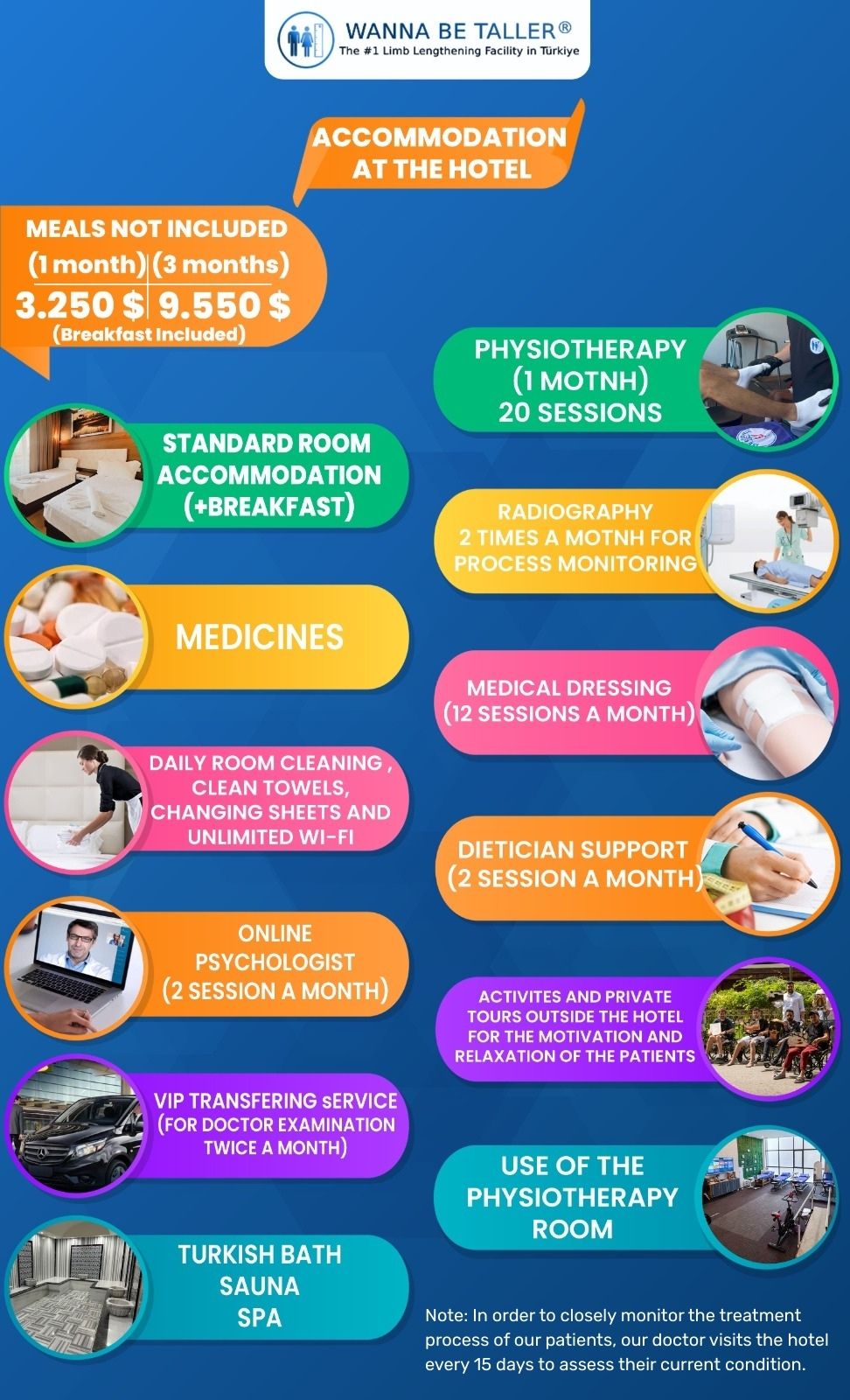
At our hotel, our friendly staff and expert healthcare professionals are always by your side. The medical support, regular health check-ups, and physical therapy services you need after surgery aim to speed up your recovery and enhance your comfort.
2. Home Accommodation: Safe Recovery in Your Own Space
Our home-style apartment accommodation service is specially designed for patients who prefer a more private space and cost-effective option. This choice provides both physical and mental comfort for those who want to recover in a home-like environment:
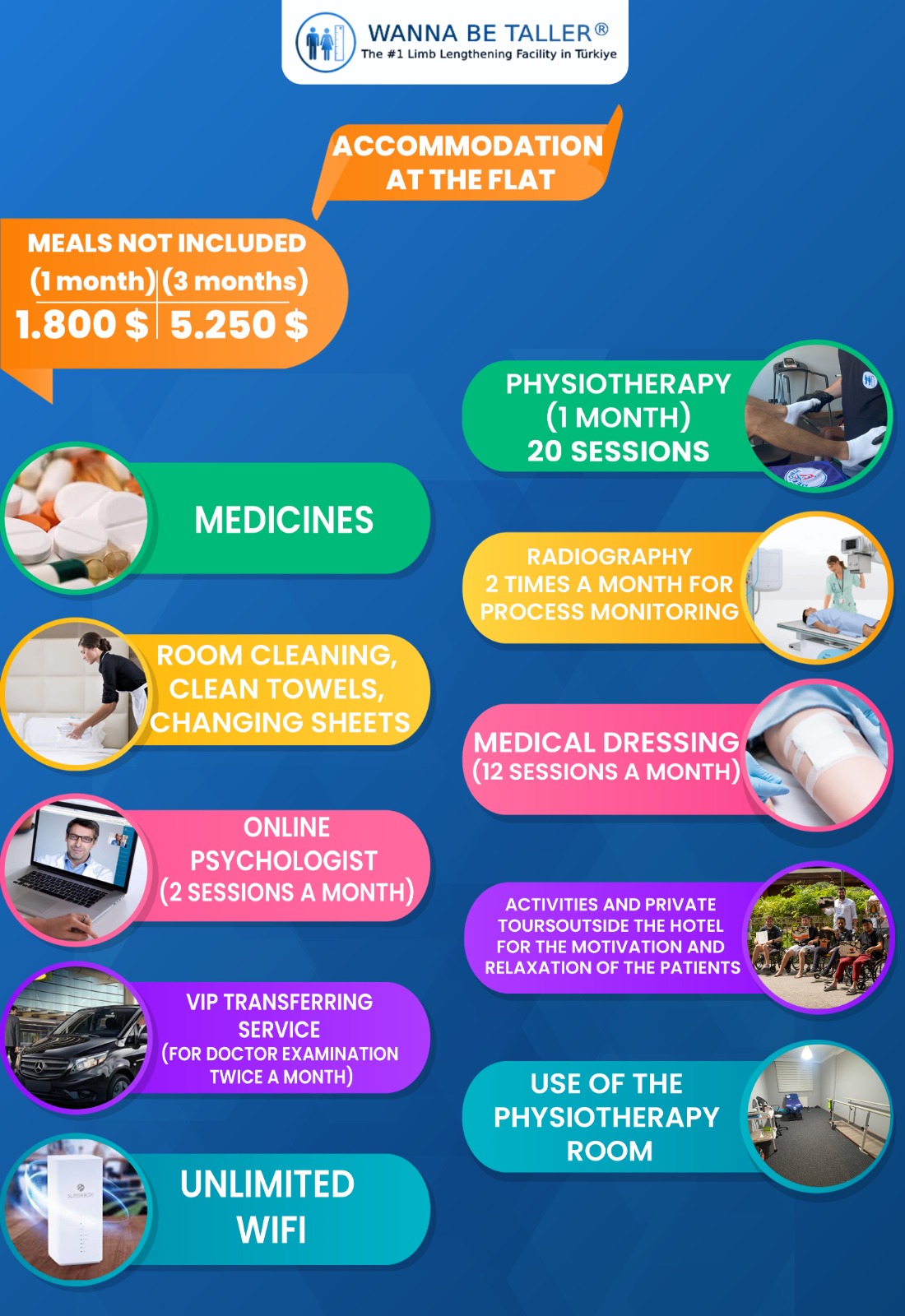
During home accommodation, our expert team provides comprehensive services such as weekly nurse visits, medication monitoring, wound care, and psychological support. These services ensure that you don’t feel alone during your recovery and can focus solely on your treatment.
You can watch the video below to see a day of our patient at the apartment.
Services Included in the Shared Price
Services We Offer
Some of the services we provide during the post-surgery period include:
- Physical Therapy: Personalized programs adapted to your needs, conducted in 5 sessions per week.
- Health Monitoring: Mobile X-rays and doctor evaluations every 15 days without requiring you to leave your location.
- Psychological Support: Online therapy sessions to support your emotional well-being.
- Companion and Nursing Service: Dressing changes, wound care, medication monitoring, doctor check-ups, and general health evaluations every 2-3 days.
- Extra Comfort: Spa, sauna, and fitness services at the hotel; a peaceful environment in individual living spaces at home.
Frequently Asked Questions (FAQ): Limb Lengthening Surgery
We’ve compiled the most frequently asked questions and answers about limb lengthening surgery. This information will help you gain a general understanding of the process and make an informed decision.
- Who Is Eligible for Limb Lengthening Surgery?
It is suitable for individuals aged 18-55 whose growth plates have closed. People with leg length discrepancies, dwarfism (achondroplasia), or those wishing to increase their height for aesthetic reasons may opt for this surgery. - How Much Lengthening Can Be Achieved After Surgery?
Depending on the method used, typically 6-10 cm of lengthening can be achieved. Methods like Precice allow for up to 8.5 cm, while the LON method can extend up to 10 cm. Additional surgeries may be required for greater lengthening. - What Is the Recovery Time After Surgery?
The lengthening process usually takes 2-3 months. An additional 6-9 months is required for complete bone healing and walking without support. Full recovery and resuming intense physical activities typically take 12-18 months. - Is There Pain After the Surgery?
Pain may be experienced during the first few days after surgery but can be managed with painkillers. During the lengthening phase, discomfort or mild to severe pain may occur due to bone and muscle tension. This pain is more noticeable during movement but can be mitigated with proper exercises and guidance from a doctor and physiotherapist. Regular adherence to a good exercise program ensures a more comfortable and pain-free process. - Is the Height Gained from Surgery Permanent?
Yes, the height gained from limb lengthening surgery is permanent. Once the bones are fully healed, there is no risk of shortening. - Does the Surgery Leave Scars?
In modern methods, surgical scars are generally small and fade over time. Methods like Ilizarov and LON may result in more scarring, while Precice leaves minimal scars. Scars can be minimized through nursing care, specialist guidance, creams, dermatological treatments, or laser therapies. 

- What Is the Cost of Surgery?
At our center:
- LON method: $22,850
- Precice method: $54,000
Before making a decision, it is advised to confirm what is included in the costs at your chosen facility and ensure there are no hidden fees. It’s also recommended to obtain this information in writing (e.g., an official offer). Many patients have reported encountering higher costs than expected due to unforeseen expenses. Careful review, written agreements (e.g., official offers, signed deposit agreements, service contracts), and visiting the facility can help you maintain control over the process. - Does Insurance Cover Surgery Costs?
Limb lengthening surgery is typically considered a cosmetic procedure and is not covered by insurance. However, surgeries performed for medical reasons may be partially covered by some insurance companies. - How Long Does the Surgery Take?
The surgery usually takes 2-4 hours. Precice surgery may be 30-60 minutes shorter than the Combined method, depending on the surgeon’s experience. During the lengthening phase, 1 mm of lengthening is achieved daily across all methods. - Which Method Is Better?
This depends on the patient’s budget, expectations, and health condition. Ilizarov and LON methods are more cost-effective, while Precice and Precice Max offer more comfort and aesthetic results. Many patients choose the LON method for its price-performance. For better decision-making, it is helpful to consult a doctor, calculate your budget, and talk to patients who have undergone each method. - Can I Play Sports After Surgery?
Yes, sports can be resumed after full bone healing. This usually occurs one year after surgery and requires the doctor’s approval. - How Safe Is the Surgery?
Limb lengthening surgery is very safe when performed by an experienced surgeon. The risk of complications can be minimized through regular follow-ups and physical therapy.
CONCLUSION: A SAFE, PROFESSIONAL, AND SUPPORTIVE PROCESS
Limb lengthening surgery is a major transformation that can significantly enhance your quality of life. However, the process requires careful planning, a specialized team, and a patient-centered approach. Being well-informed at every stage—from decision-making to recovery—and supported by a professional team is critical to achieving successful results.
As the first company established in Turkey specializing in limb lengthening surgery, we are proud to have provided a safe journey for hundreds of patients with our expertise and professional approach. Our experienced team and patient-focused service have made us the choice for individuals from many countries dealing with height concerns. This experience allows us to manage each patient’s process to the highest standards and tailored to individual needs.
Our goal is not only to help you achieve your physical goals but also to ensure that you feel safe and supported throughout the entire process. Accessing accurate information and professional guidance is one of the most important steps when making a significant decision like limb lengthening surgery.
You can always reach out to our expert team to understand what this process means for you and to make the most informed decision. We are here with personalized solutions and comprehensive consultation services to help you achieve the change you’ve dreamed of and complete this journey with confidence. For more information and to create the best treatment plan for you, contact us. Our professional team is here to answer your questions and support you.
Telephone&WhatsApp: +90 531 988 3090
E-mail: support@wannabetaller.com
Instagram: @leg_lengthening_surgery

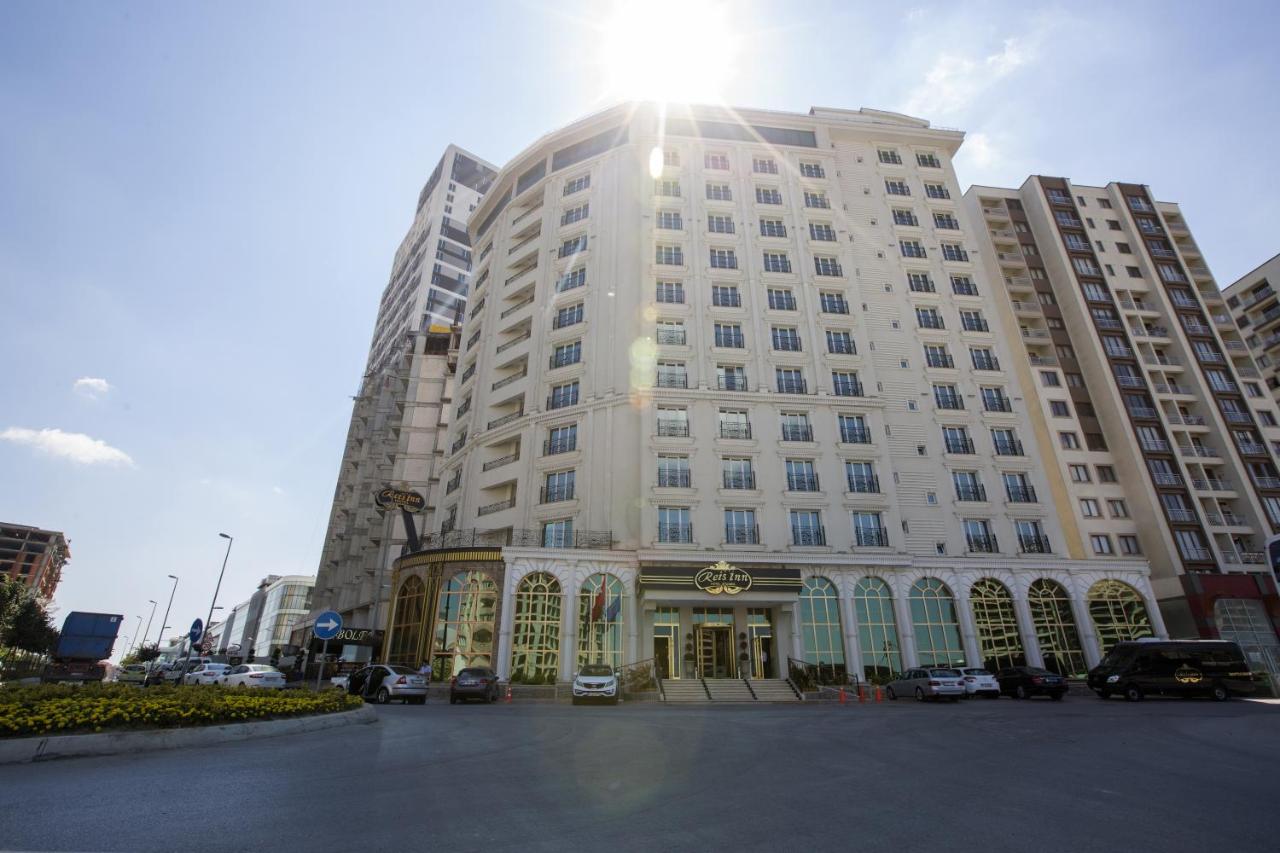


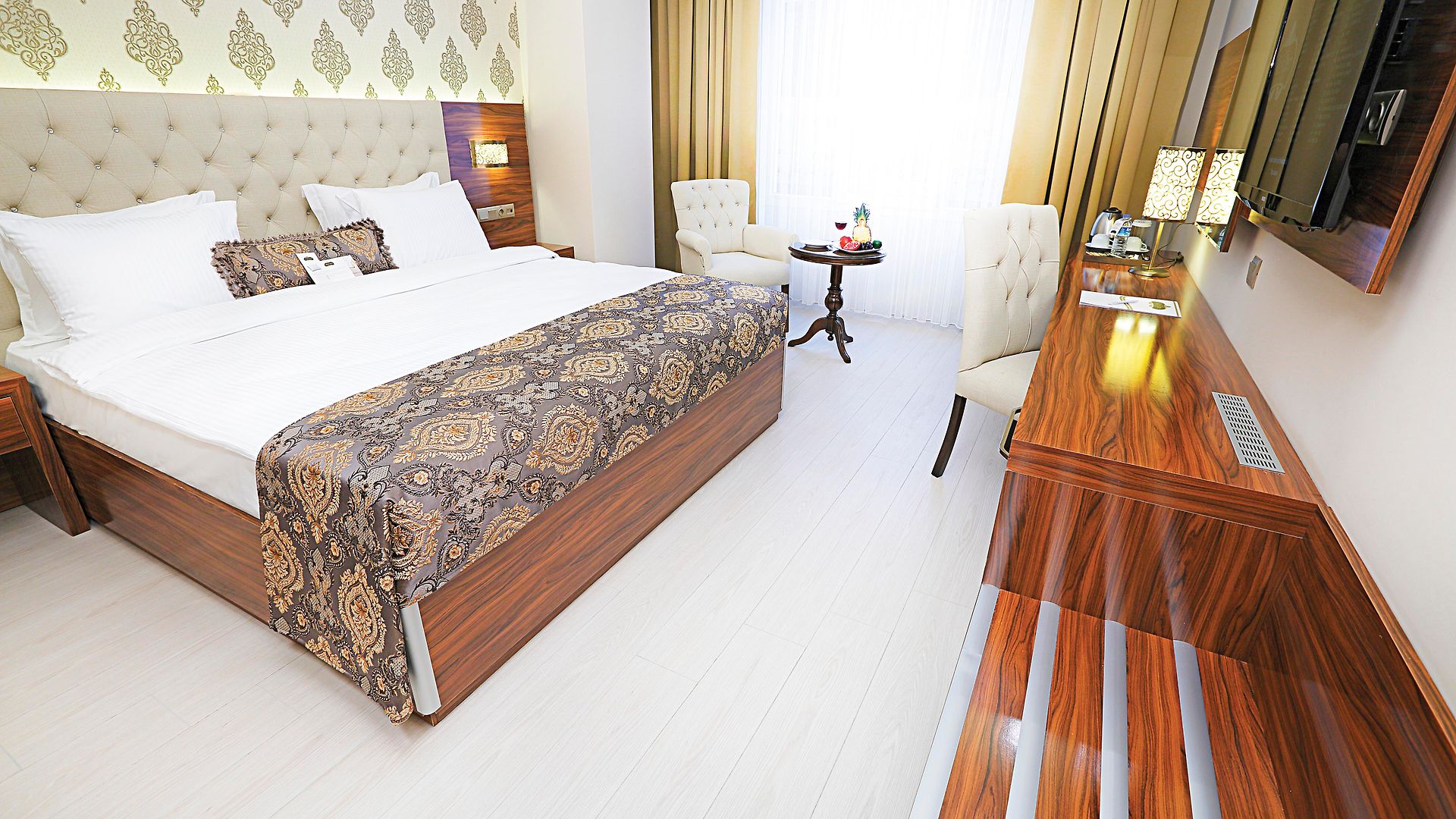
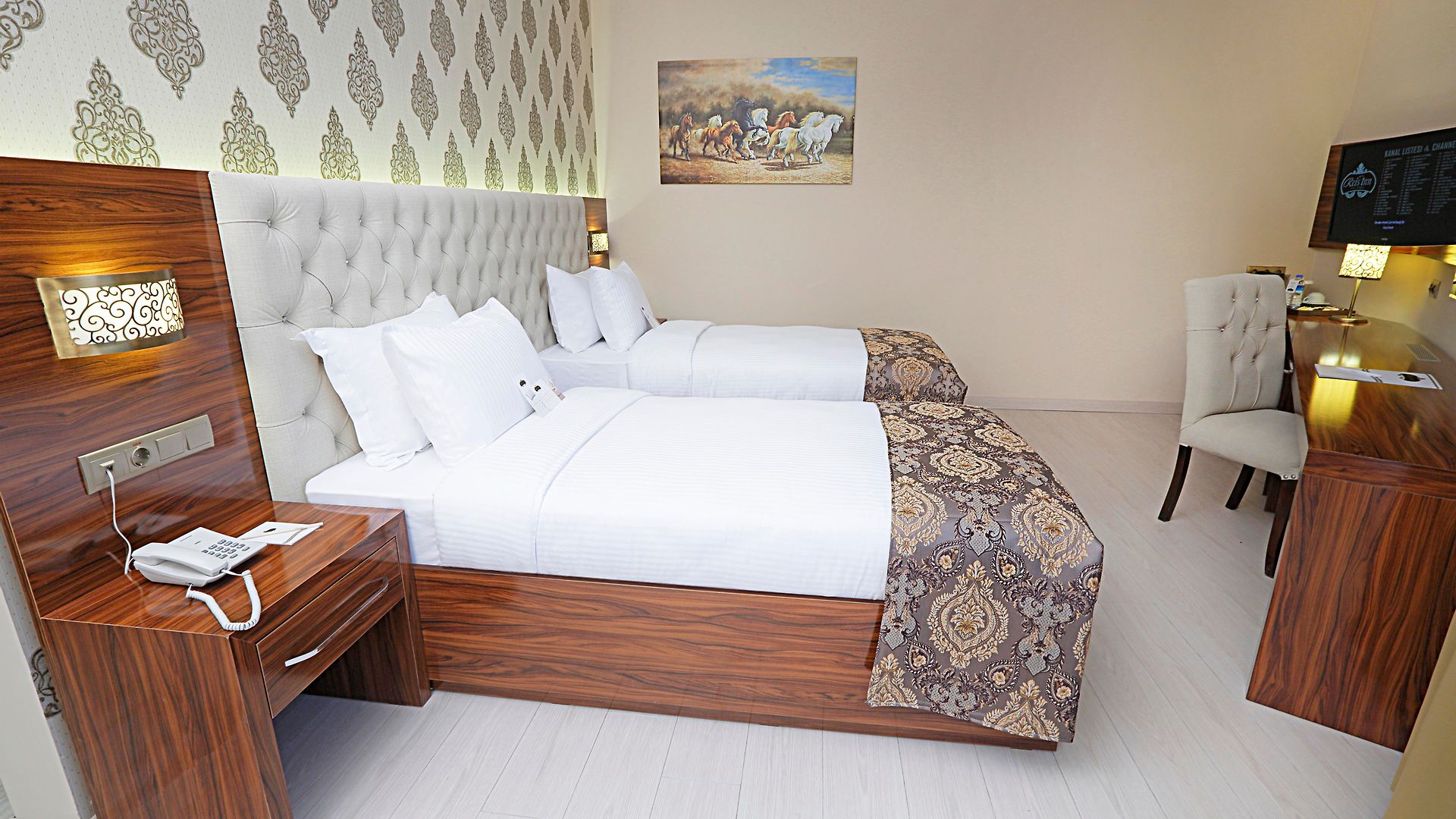
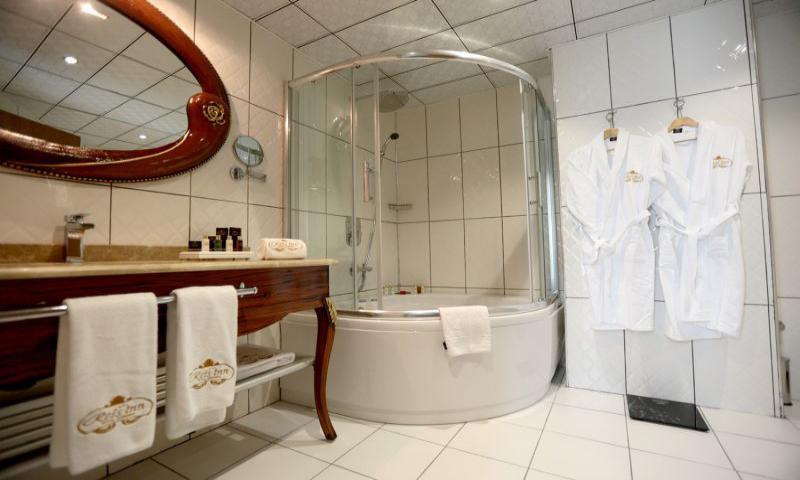
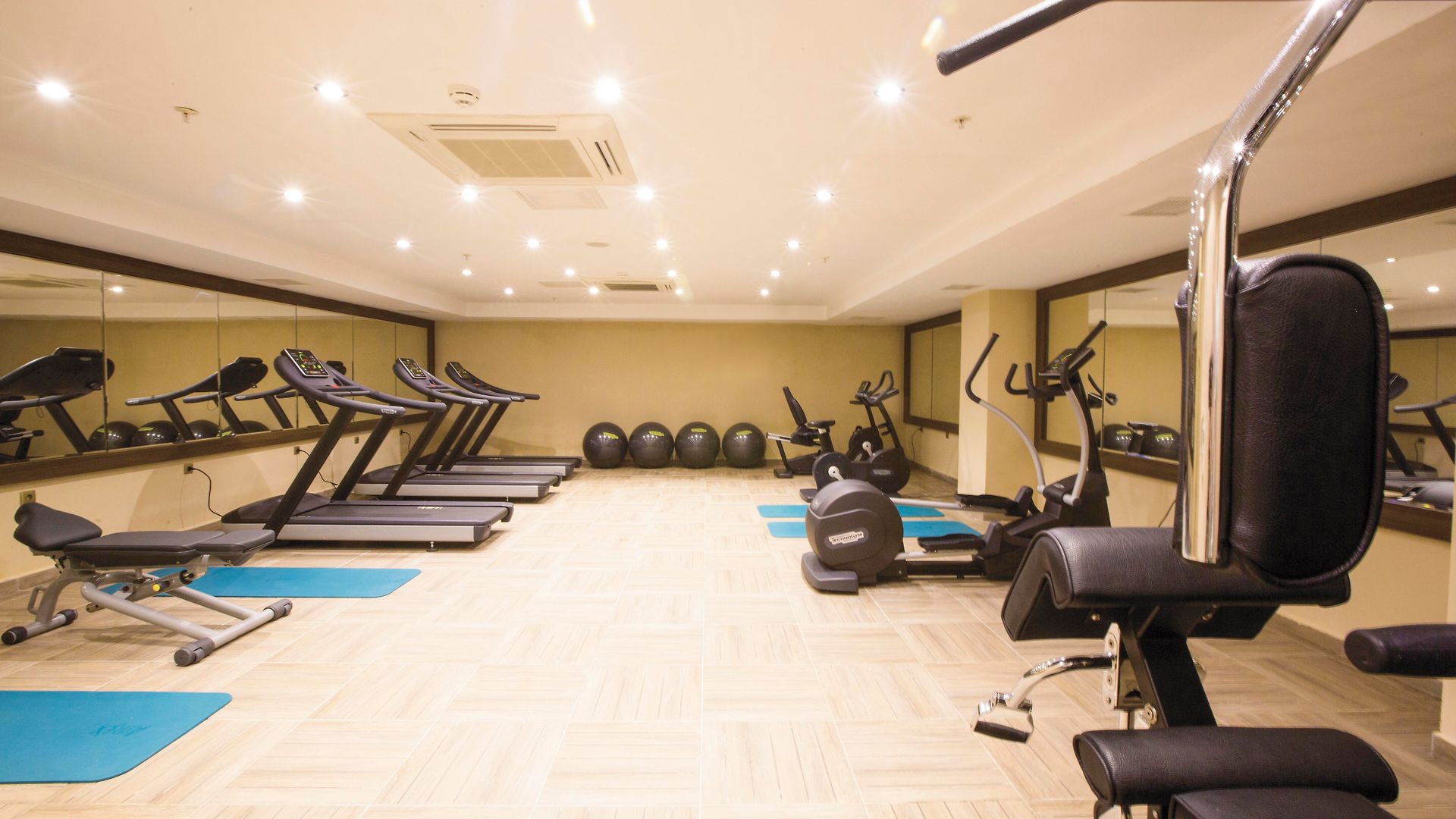
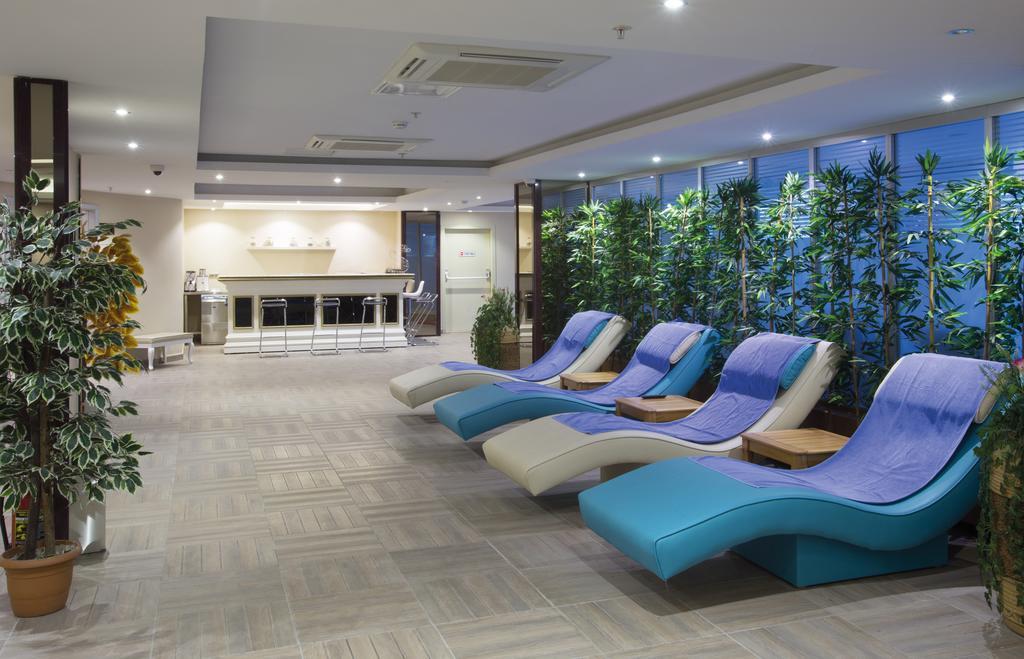
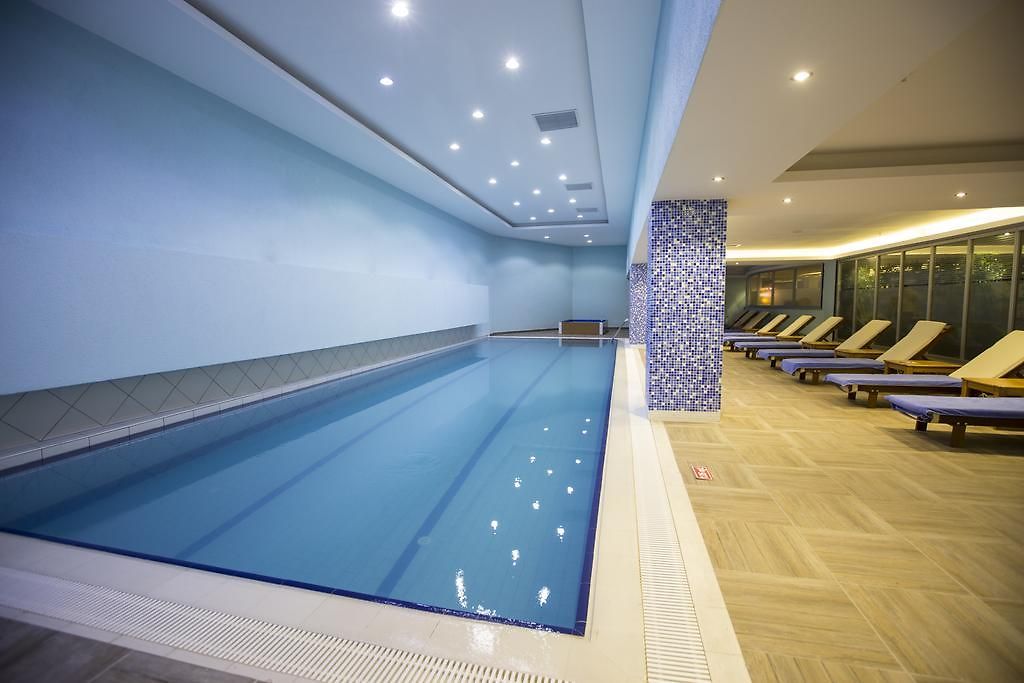
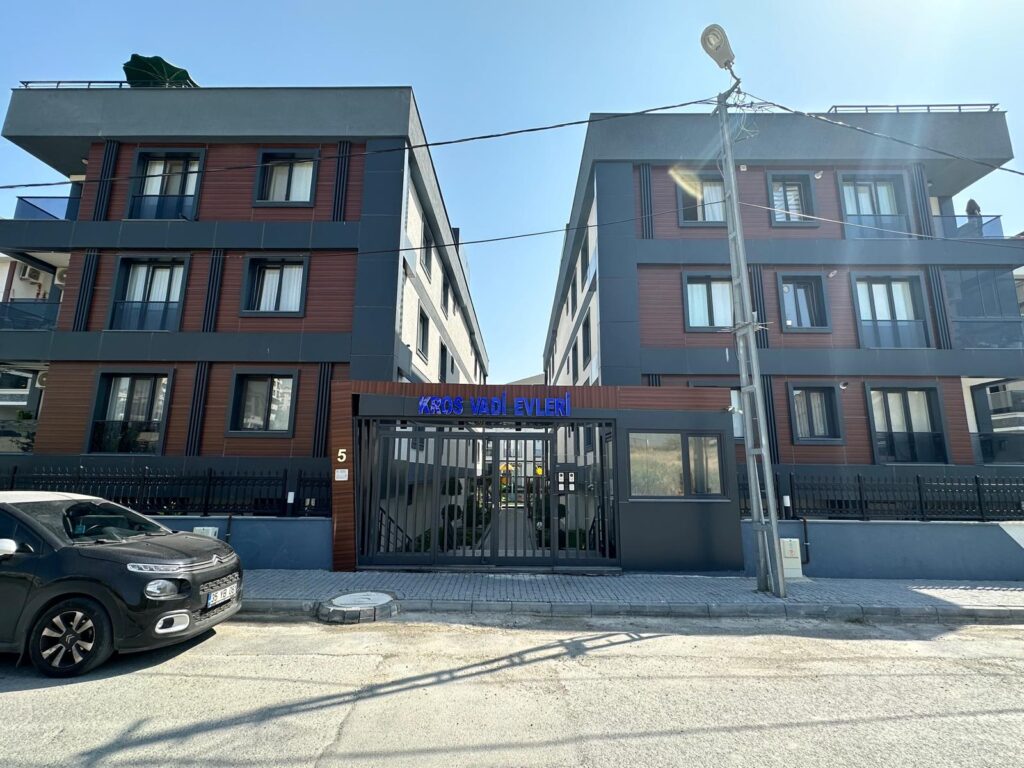
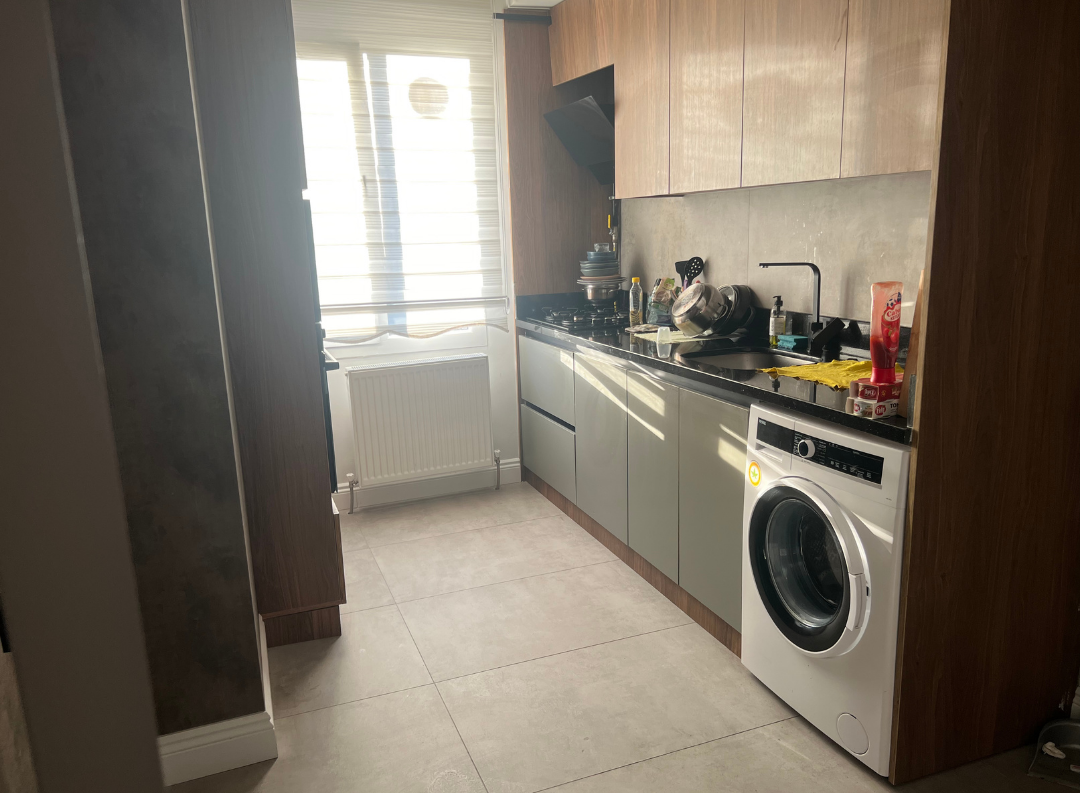


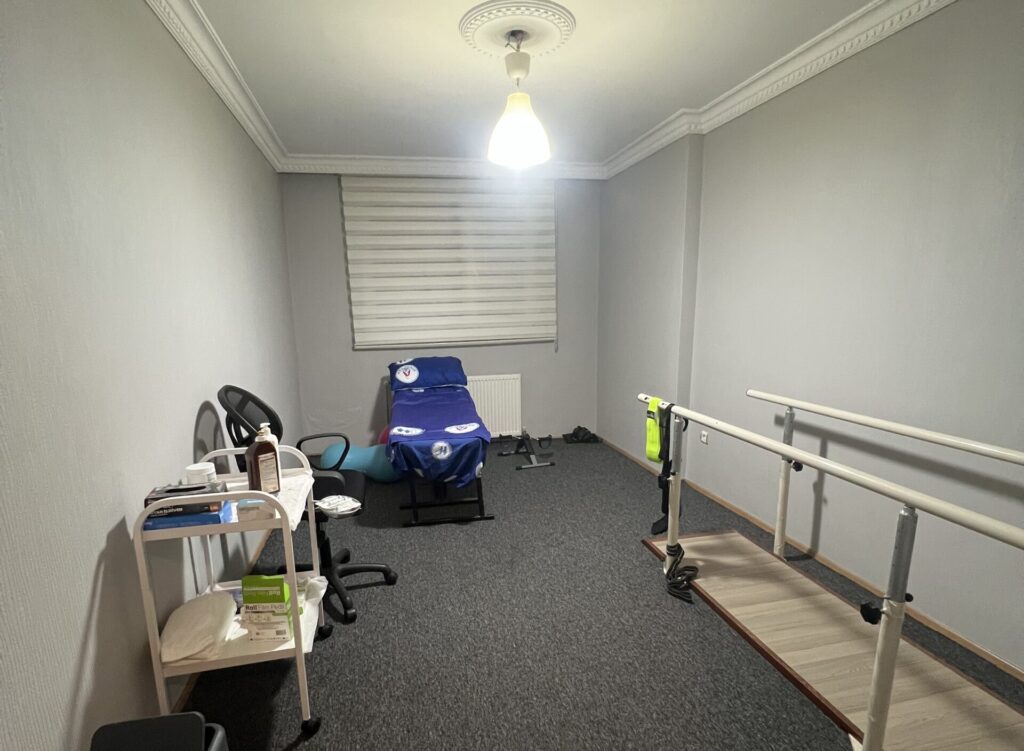
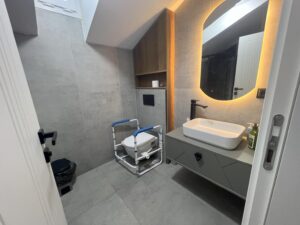

 (1).jpg)